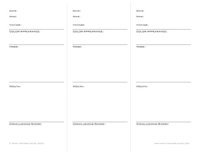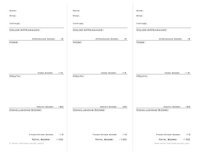Wine Tasting Forms
Looking for wine tasting forms? Writing down notes or scores of wines you taste has many purposes. For one, they can help you remember the wines you've tasted and you can refer back to them later to remember what you thought of the wine. However, they can also be a critical and integral part of the wine tasting and assessment process. Writing down thoughts and scores forces you to think about the wine, to put into words its characteristics, its charms, its faults. This process helps you get into all the depths of the wine, taking it apart from the inside out.
This process is important both for a wine beginner who is just learning how to assess wine and how to communicate your opinions of a wine AND for an experienced wine lover. Even after years of tasting wine, it still helps to get into the moment and to critically assess a wine if you have to put the experience into words. Sometimes, the emotional aspects of wine appreciation are hard to put into words and you don't have to intellectualize every bit of it. But it can be an opportunity to get a bit poetic. "This red Rhone wine is like a beautiful topless redhead on a tractor…" to paraphrase a description from a Kermit Lynch newsletter. Don't focus just on writing down descriptors (sour, black cherry, pencil lead shavings) of things you smell or taste in the wine. Also try to put into words the wine as a whole, its balance (or lack thereof), its texture, how it makes you feel, even the "personality" of the wine.
Below are a couple wine tasting forms that can help you organize your wine assessments and notes. Print the wine tasting forms up and make as many copies as you need. They are PDF files so you can either download them or just print them up.
 Basic Wine Tasting Note Template
Basic Wine Tasting Note Template
This is a simple, streamlined version of a wine tasting note sheet with ample room to write your basic impressions and descriptions of each wine. There are sections for the wine's color, nose (aroma) and mouth (flavor and texture) to fully describe the details of a wine. This form just gives you the space, it is up to you to wax poetic about each wine and describe it in a way that someone else could read and get a good sense for what the wine might smell and taste like, its flaws (if any) and its virtues.
 Wine Tasting Note Sheet with Scoring Template
Wine Tasting Note Sheet with Scoring Template
Numerical scoring of wine is a common way to quickly represent your general impressions of a wine. There are several different scoring systems, from the 3 start system to the 20 point system and others. However, by far the most famous and commonly employed wine rating system is the 100-point scale popularized by Robert Parker, the famous and influential wine critic. These wine tasting forms are each also a wine tasting scorecard that help guide you through the steps of assigning a point score with this system. There is room still for other notes as well, but in each section there is an area to assign a certain number of points for each. For example, up to 5 points to color/appearance, up to 15 for nose/aroma, up to 20 for mouth and up to an additional 10 for the finish and overall impression and balance. Yes, this only adds up to 50 points. Each wine automatically gets 50 points, that is the lowest score a wine can get. So you add the points above together and then to 50 and that gives you your final 100-point scale score. Wines that are 90 points and higher are generally considered outstanding, 80 to 89 are good and below that are generally considered mediocre or even flawed.
Done reading about Wine Tasting Forms?
Return to the Wine Tasting section.










